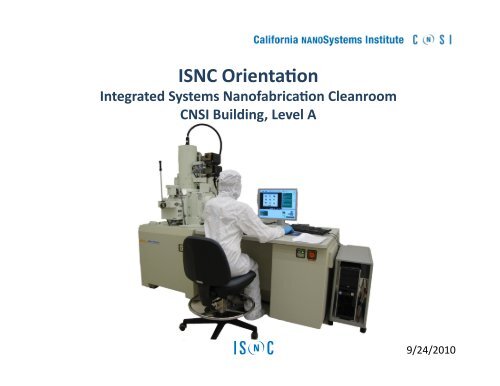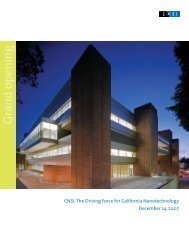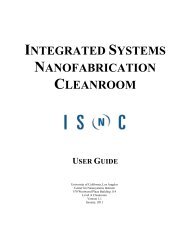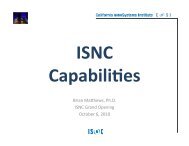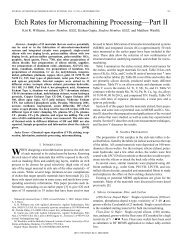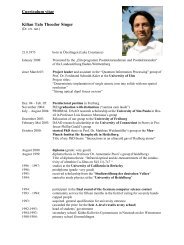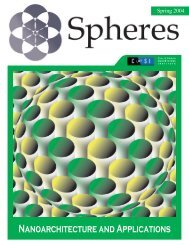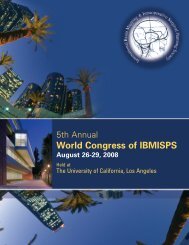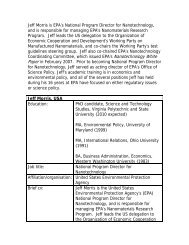ISNC Orienta9on - UCLA
ISNC Orienta9on - UCLA
ISNC Orienta9on - UCLA
You also want an ePaper? Increase the reach of your titles
YUMPU automatically turns print PDFs into web optimized ePapers that Google loves.
<strong>ISNC</strong> Orienta-onIntegrated Systems Nanofabrica-on CleanroomCNSI Building, Level A9/24/2010
Today• Go over orienta1on slides• Collect and check paperwork• Take pictures for badges• Tour Cleanroom
Outline• Steps to Become an <strong>ISNC</strong> Member• Laboratory Overview• Cleanroom Policies and Procedures• Safety Informa1on• <strong>ISNC</strong> Capabili1es
Steps to Become an <strong>ISNC</strong> Member1. Apply for online for account– hLp://clms.cnsi.ucla.edu/cnsi/clms/request-‐account– Download New User Applica1on– Download Project Form2. Sign up and aLend 1st orienta1on mee1ng– Submit New User Applica1on & Project Form3. Study User Guide4. Take Online Safety Test– hLp://www.isnc.cnsi.ucla.edu/test5. ALend 2nd orienta1on mee1ng
What is the <strong>ISNC</strong>: Mission• <strong>ISNC</strong> Mission– provide a state-‐of-‐the-‐art nanofabrica1on facility• <strong>UCLA</strong> researchers• Industry users• Educa1onal ins1tu1ons• Government Laboratories– Support Nanofabrica1on– Advance Learning– Mentoring opportuni1es• Scien1sts,• Students,• Teachers, and• The general community
What is the <strong>ISNC</strong>: Facility• Clean Room Space (~9700 sq. ].)– Class 100 – Yellow Bays• 2750 sq. ].– Class 1000 – White Bays• 6250 sq. ]. class• 6 White Bays for standard processing equipment• 2 White Bays are integrated Bio-‐suites with separate nega1ve air flow– Class 10,000-‐ Support Area• 700 sq. ].– Service Chases adjacent to each process bay• Facili1es• Air Return– high purity deionized water, high purity gasses, equipment cooling water,water-‐scrubbed exhaust, house exhaust, house vacuum, etc.
What is the <strong>ISNC</strong>:MapA208StaffOfficeSupportAreaStaffOfficeUserStorageA119BackendProcessesA125Dry DepositionA131Furnace DepositionRTAA135MetrologyA145LithographyWet ProcessesA149LithographyE-BeamClass1000Class100A212GowningA216StaffOfficeStaffOfficeA318Integrated Bio-SuiteCrump InstituteA324IntegratedBio-SuiteA330Metal DepositionA334Dry EtchA344LithographyOpticalA348LithographyWet Processes
How Does a Cleanroom Work• Filtered Air From Ceiling• Forces Par1cles to Floor• Air exits from side grates• Air put through filters reused• Turbulence is Bad– S1rs par1cles near floor– Generated by users walking– Generated by table– Generated by blow gunsLaminar Flow of AirFrom Ceiling PushesPar-cles to Floor
How Does a Cleanroom Work• Clean zones– Waist level up is clean– Air has more par1cles at floor• Classes– # of par1cles ≥0.5µm per ] 3 of air– 10• E-‐beam writer chamber– 100• 4 lithography Bays– 1000• 8 White BaysLaminar Flow of AirFrom Ceiling PushesPar-cles to Floor
What is the <strong>ISNC</strong>:Equipment & ProcessesLithography Etch Deposi-onMetrology Thermal Processes Miscellaneous
What is the <strong>ISNC</strong>: Staff• Full-‐Time Professional Engineering Staff– Process Development– Process Advice and Troubleshoo1ng– Equipment Training– Equipment Maintenance– Monitor Safety• Part 1me support from NRF (Nanolab) Staff
What is the <strong>ISNC</strong>: StaffName Area Office Loca-on Email TelephoneKang Wang Faculty DirectorSteve Franz Technical Director E-‐IV – 14-‐131A franz@nanolab.ucla.edu 310-‐206-‐8923Adriane Nolan Administra1ve Assistant CNSI -‐ B128 anolan@cnsi.ucla.edu 310-‐206 8324Brian MaLhews Research Engineer CNSI – A216 maLhews@cnsi.ucla.edu 310-‐983-‐3255Ghassan Malek Lithography CNSI – A216 ghassan@cnsi.ucla.edu 310-‐983-‐3179Da Teng Lithography CNSI – A216 teng@seas.ucla.edu 310-‐983-‐1107Yuwei Fan Nano-‐Lithography CNSI – A216 ywfan@ee.ucla.edu 310-‐983-‐3275Lorna Tokunaga Wet & Thermal Process CNSI – A216 lornat@cnsi.ucla.ed 310-‐983-‐3413Krissy Do Assistant CNSI – A216Tony Wright Cleanroom Support CNSI – A216 tonywright@cnsi.ucla.edu 310-‐983-‐1182NRF Support EngineersTom Lee Etch E-‐IV – 14-‐131A leet888@yahoo.com 310-‐206-‐4641Hoc Ngo Metals E-‐IV – 14-‐131A hoc@seas.ucla.edu 310-‐206-‐5528Huynh Do PECVD E-‐IV – 14-‐131A huynhd@seas.ucla.edu 310-‐206-‐4641Wilson Lin Thin Film, Metrology, & ALD E-‐IV – 14-‐131A yousheng@seas.ucla.edu 310-‐206-‐8923Joe Zendejas Mask Shop & 2 nd Shi] E-‐IV – 14-‐131ANoah Bodzin FIB & SEM E-‐IV – 14-‐131Azendejas@ee.ucla.edu 310-‐206-‐5528nbodzin@seas.ucla.edu 310-‐983-‐3312
What is the <strong>ISNC</strong>:Cleanroom Management System• Web component– hLp://lr.isnc.cnsi.ucla.edu– Tool informa1on– Training– Reserva1ons– Calendar• Badge Readers– Entry and Exit– Record 1me inside cleanroom• Touch-‐Screen Terminals– Ac1vate and de-‐ac1vate equipment– Record 1me equipment used
Outline• Steps to Become an <strong>ISNC</strong> Member• Laboratory Overview• Cleanroom Policies and Procedures• Safety Informa1on• <strong>ISNC</strong> Capabili1es
<strong>ISNC</strong> Laboratory Access• Loca1on:– CNSI Building, A Level– Cleanroom entry through A210– CNSI Building Access Card required• Hours:– Building: Open 24/7– Cleanroom: Open 24/7• Buddy System -‐ two people must bein cleanroom at all 1mes– Staff support:– 8 AM to 6 PM, M-‐F• Cleanroom Tours:– Advanced no1fica1on is given to lab director– One 1me visit (i.e., not several consecu1ve days)– Three or less visitors at a 1me– Visitor to be properly gowned, obey all rules and be withhost at all 1mes– Visitor must only observe and not par1cipate or touchequipment or chemicals
Laboratory Charges• Account Startup Fee– Covers account startup costs including badge and startup kit• Cleanroom Use Fees– Cleanroom Use Fee• Time inside of cleanroom is recorded by badge readers on cleanroom door– Equipment Fees• Equipment Fees are billed based on actual usage 1me• Not all equipment has an associated fee– Minimum Charge for industrial users– Materials Fees (Au, Pt, etc..)• Scheduled Training– Cleanroom Use Fees– Equipment Fees if applicable– Credits given to superusers for helping to train– No engineering charge unless training is specially scheduled• Engineering Time Charged for special requests• Billing is done at beginning of each month
Laboratory ChargesTwo-‐Tiered Rate StructureAcademic Rate• Lower Rate• No monthly minimum• Graduate Students• Researchers• Faculty• Undergraduate students– Professor support and <strong>ISNC</strong>approval required• Collaborators with Faculty– <strong>UCLA</strong> PI & <strong>ISNC</strong> authoriza1onrequiredNon-‐Academic Rate• Higher Rate• Monthly minimum• Industry• Government Laboratories• Other governmentresearchers
Materials Supplied by <strong>ISNC</strong>• Cleanroom Garments– Hood– Coveralls– Shoe Covers– Gloves– Beard Cover• Personal Protec1ve Equipment– Safety Glasses– Chemical Aprons– Face Shields
Materials Supplied by <strong>ISNC</strong>Chemicals• Supplied as part of Cleanroom Use Fee– Solvents – Acetone, Alcohol, NMP, & others– Lithography chemicals -‐• Photoresist – SPR-‐700 1.2, NLOF, PMMA (450k and 950k),SU-‐8, & others• Developer – Alkiline Developer MF-‐26A or equivalent, SU-‐8Developer, & others– Acids – HF, BOE, HCl, H 2 SO 4 , Nitric, & others– Bases – KOH, Ammonium Hydroxide, & others– Metals – Al, Ti, Cr, & others• For a complete list refer to the <strong>ISNC</strong> User Guide
<strong>ISNC</strong> Communica-onsWebsite• hLp://isnc.cnsi.ucla.edu• New Member Informa1on• Facility Informa1on and Capabili1es• Document and Form Downloads• Member Sec1on
<strong>ISNC</strong> Communica-onsLaboratory Management System• hLp://lr.isnc.cnsi.ucla.edu• Equipment Informa1on– Opera1onal Specifica1ons– Status• Equipment Reserva1ons• Facility Calendar• Training Management• Time Tracking for Billing– Cleanroom use via badge readers– Equipment use via touch-‐screen terminals
<strong>ISNC</strong> Communica-onsEmail• <strong>ISNC</strong>-‐User@lists.ucla.edu• Your name is automa1cally added to email listwhen you become a cleanroom member• e-‐mail is used to no1fy you as news develops• Equipment status– Problems and fixes– Special lab events, training, closures, etc…• Staff email addresses listed on website and inLabrunr
<strong>ISNC</strong> Communica-onsTelephone & Paging System• Dial 911 for emergencies• Main Office number is 310-‐(98)3-‐3183• 7 telephones in cleanroom• 2 telephones in corridors outside cleanroom• Telephone Directory posted above each telephone• Main Cleanroom number is 310-‐(98)3-‐3331– Campus Dialing: 5 digit extension– Local Dialing: 1 + Area Code + 7 digit number– No Long Distance Dialing• Intercom System– Press “Page” and input zone code– Instruc1ons posted at telephone– Can be used to evacuate cleanroom
Entering the Cleanroom• No– open-‐toed shoes– Sandals– Shorts– Skirts– tank tops– high heels– hats– Sweaters– Jackets– Bags– Umbrellas– Excessive cosme1cs orfragrancesDress Code• Yes– Long Pants• Must reach ankle• Use sweats or surgical scrubsto cover up shorts– Shirts with sleeves– Close toed shoes
Entering the CleanroomBadge ReadersCleanroom EntranceBadge ReaderGreen Light WhenDoor is UnlockedBadgeReaderTacky Mat
Entering the CleanroomP e-GownPre-‐Gowning Room• Shoe Covers in hallway– Tuck laces into covers• Step on tacky mat at door• Login with badge and enter• Put On:– Hairnet• Tuck in all hair– Gloves• Keep gloves clean• Put on last• Go to main gowning room1. Hairnet3. Gloves2. Shoe coversTuck Hair Fullyinto HairnetKeep GlovesCleanTuck Lacesinto Shoe Covers
Entering the CleanroomGowGowning Room• Put on Cleanroom Hood• Put on Cleanroom Garment– Do not to drag the garment on– Tuck hood into the garment• Tuck Sleeves into Gloves• Snap Pant Cuffs• Put on Cleanroom Shoe Covers• Put on Safety Glasses• Put on Facemask• Check for Proper Gowning in Mirror– No hair visible– Hood fully tucked into garment– Sleeves tucked into gloves– Shoe laces tucked– Badge on outside of garment• Step on the tacky mat as you enter thecleanroomSafety GlassesCleanroomGarmentBadge onOutsideTuck Sleevesinto GlovesSnap Pant CuffsHoodFace maskTuck Hood Fullyinto GarmentGlovesShoe covers
• Remove:Exi-ng the CleanroomGowning Room– Facemask (dispose of in trash)– Cleanroom shoe covers (snapthe boots to the boLom of thepant leg)– Cleanroom garment– Cleanroom hood• Snap hood to the garment collar– Safety glasses• Store in bag on hanger• Enter the pre-‐gowning room
Exi-ng the CleanroomPre-‐Gowning Room• Remove and throw out– Hairnet– Gloves• Log out of the cleanroom• Exit the pre-‐gowning room• Remove blue shoe coversreturn to binGreen Light WhenDoor is Unlocked
Equipment: Training• Approval and training required for all equipment• Training and supervision is done by superuser or staff• More complex equipment requires 2 step training:– 1 st session with a small group (5-‐7)– 2 nd session (cer1fica1on) alone (bring real substrate to process)• Sign up for training in Labrunr by adding name to waitlist• Bring opera1onal specifica1on training sessions– Opera1onal specifica1ons can be found on Labrunr• A]er final training, machine can be reserved and used• Major equipment is interlocked and can’t be used un1lapproved• Gexng trained takes 1me– It can take several months before a user can run their fullprocess
Equipment: Reserva-ons• Only trained and authorized users may reserve equipment– Reserva1ons made through Labrunr• Not all equipment can be reserved• If you cannot meet your reserva1on– cancel reserva1on immediately– email <strong>ISNC</strong>-‐Users@lists.ucla.edu so that others may take your reserva1on• Reserva1on 1me limit– Each machine has a maximum number of hours/day a PI or company canreserve• If a machine is not reserved– walk-‐up users may reserve and use the machine• If you are late to a reserva1on– Reserva1ons are held for a maximum of 10 minutes past start 1me– If you do up a]er 10 minutes, other authorized users may use the machine– For no-‐shows who have not no1fied us, their reserva1on privileges will besuspended
Equipment: Opera-ng• Do not operate equipment you arenot trained on1. Check logbook for errors orproblems2. Sign in to logbook3. Ac1vate equipment in Labrunr4. Run Process5. Fill in log book data from run6. Sign out of Logbook7. De-‐ac1vate equipment in Labrunr
Inside the CleanroomE-queSe – Dos• Do:– Cleanup a]er yourself– Label beakers:• Name, Contents, Time and Date started, Time and Date you willfinish, Telephone Number– Read and obey ALL signs– Turn off DI water when finished– Get to know your fellow researchers– Volunteer to help in the laboratory and be a superuser– Put things back when you are done– Leave room for others at wet benches– Leave wet benches dry a]er use
• Do not:Inside the Cleanroom– Open your garmentE-queSe – Don’ts– Talk on your cell phone– Make a mess– Use equipment that you are not trained on– Borrow equipment or material without permission– Leave beakers on a wet bench for more than 24hours
Outline• Steps to Become an <strong>ISNC</strong> Member• Laboratory Overview• Cleanroom Policies and Procedures• Safety Informa1on• <strong>ISNC</strong> Capabili1es
<strong>ISNC</strong> SAFETY: General• Read and understand <strong>ISNC</strong> User Guide• Wear safety glasses, goggles, or side shields at all1mes• Read MSDS sheet on all chemicals you use• Know loca1on of emergency equipment– Safety showers and eye washes– Fire ex1nguishers– First aid kits– Chemical spill kits– Emergency exits• Never be in the cleanroom alone a]er hours– Violators of the “Buddy System” will be suspended• Use of HF&BOE require special training• Do not touch or use equipment that you are nottrained on
<strong>ISNC</strong> SAFETY: Evacua-on• When to Evacuate– Earthquake– Fire– Explosion– Toxic Gas Alarm– Announcement• How to Evacuate– Take maximum of 10seconds to secure work– Exit cleanroom• Do not take off garments– Exit emergency exit• Do not use elevators• If necessary pull fire alarm– Gather in court ofsciences
Evacua-on Plan
<strong>ISNC</strong> SAFETY: Chemicals• Wet chemicals are the most likely cause of injuryin the cleanroom• Bringing Chemicals into Cleanroom– Chemicals must be listed in MSDS book before beingallowed in cleanroom– If not in MSDS book, bring 2 copies of MSDS and waitfor approval and storage informa1on– Put date, professor/company name, and telephonenumber on boLle– Chemicals more that 6 months old may be disposed ofby staff, change date for more 1me
<strong>ISNC</strong> SAFETY: Wet Chemicals• Transpor1ng Chemicals– Between Process Bays• Use rubber spill containment carrier• If you route goes into the main hallway youneed a containment carrier– From outside of Cleanroom• Use a cart with a containment lip• All Chemicals must be poured atworking wet bench• Do not heat highly flammable liquids– Alcohol– Acetone• Do not move hot chemicals
<strong>ISNC</strong> SAFETY: Chemical Storage• All chemicals must be segregated andstored appropriately• All chemicals are segregated and stored inchemical cabinets by class:– Solvents– Acids– Bases• Further segrega1on is done by shelf:– Organic Acids– Strong Inorganic Acids– Oxidizing inorganic acids• If you are unsure, ask• Never store chemicals in your locker• Do not leave chemicals out of cabinetswhen not in immediate use• Do not put chemicals on floor with out aspill containment carrier
<strong>ISNC</strong> SAFETY: Wet Benches• Use appropriate wet bench (Solvent, Acid, Etc.)• Verify wet-‐bench exhaust– Do not use bench if exhaust is inadequate– If you can smell strong odors: Stop, Evacuate, and No1fy Staff– Push strongly fuming chemicals to back• Leave bench clean and dry when finished• Push unaLended beakers to back of bench• Turn off hotplates when finished
<strong>ISNC</strong> SAFETY: Beakers• Label all beakers before pouring chemicals– Contents– Name– Date and Time Start– Date and Time End– Phone number if leaving cleanroom• Open beakers with chemicals– Must stay inside a wet bench at all 1mes– Must be labeled– Should be covered when not in use• Do not leave beakers in wet bench for morethan 24 hours– Staff may dispose of solu1ons and samplesover the 1me limit• Do not cover acid or base beakers withaluminum foil
<strong>ISNC</strong> SAFETY: Wet ChemicalsPersonal Protec-ve Equipment (PPE)• What PPE to Use– Chemical Apron (<strong>ISNC</strong> Supplied)– Face Shield (<strong>ISNC</strong> Supplied)– Chemical Gloves (User Supplied)• PPE is mandatory– When pouring chemicals– Whenever splash is possible– Some chemicals have reduced PPE• Do Not– Wear chemical gloves away fromchemical bench
<strong>ISNC</strong> SAFETY: Wet ChemicalsSteps to Pour a Chemical1. Make space a wet bench2. Label beaker3. Put on PPE4. Get chemical from cabinet5. Pour chemical6. Rinse and dry boLle7. Rinse and dry gloves8. Put chemical back in cabinet9. Take off and store PPE10. Perform process*If you finish a chemical boLle youmust triple rinse itPut on PPE in this order:1. Chemical Apron2. Face Shield3. Chemical GlovesTake off in reverse order
<strong>ISNC</strong> SAFETY: Chemical Waste Disposal • Restricted Condi1on – Drain • Only water – BoLles • All waste • Normal Condi1on – Drain • Select chemicals • See User Guide for list – BoLles • All other chemicals
<strong>ISNC</strong> SAFETY: Chemical Waste • Chemical Waste must be poured at wet bench • PPE is mandatory when pouring waste 1. Find appropriate waste boLle 2. Put on PPE 3. Retrieve BoLle 4. Pour chemical 1. Only fill only to top of s1cker 5. Rinse and dry boLle 6. Rinse and dry gloves 7. Put waste boLle back in cabinet 8. Take off and store PPE
<strong>ISNC</strong> SAFETY: Chemical Waste Special Circumstances • Vented Caps – Solu1ons with H 2 O 2 or Hydroxides – relieve pressure – Without vented caps boLles can explode • Making a new waste boLle – Get a triple rinse boLle – Rinse one last 1me – Fill out Chemical Waste Label • Do not use formulas or abbrevia1ons • Place over triple rinse label • Hot Chemicals – Allow hot chemicals to cool before pouring
<strong>ISNC</strong> SAFETY: Chemical Spills • If a spill is large or seems dangerous, cordon off area and call staff • Steps to cleanup small spills 1. Wear personal protec1ve equipment 2. Turn off any hotplate or heat sources 3. Neutralize the spill if spill contains acids or bases 4. Contain the spill and soak up with spill pillows or wipes 5. Label a chemical waste bag with a chemical waste tag 6. Place contaminated materials in a chemical waste bag and seal 7. Store chemical waste bag in appropriate chemical cabinet 8. No1fy <strong>ISNC</strong> staff of the spill
<strong>ISNC</strong> SAFETY: Chemical Exposure • Steps to take in the event of chemical exposure 1. Remove contaminated clothing 2. Flush with cold water for 15 minutes • Safety shower • Eye wash • DI Spray at Wet Bench 3. Get help from other lab members or lab staff 4. Report all chemical exposures to <strong>ISNC</strong> staff 5. For life threatening exposures call 911 6. For chemical exposures to the eyes a medical exam is mandatory
<strong>ISNC</strong> SAFETY: HF/BOE Exposure • HF/BOE exposure can be life threatening • HF/BOE exposure may not be felt immediately • Steps to take in the event of chemical exposure 1. Remove contaminated clothing 2. Flush with cold water for 5 minutes 3. Get help from others 4. Apply Calcium Gluconate Gel to the affected area • Use gloves to avoid secondary exposure of fingers • Found at first aid kits, spill kits, and acid cabinets 5. Report all HF exposures to <strong>ISNC</strong> staff 6. Seek medical aLen1on
<strong>ISNC</strong> CAPABILITIES General • Wafer pieces to 6 inch substrates • Lab accommodates III-‐V, Si, glass and many other substrates • Some equipment is dedicated for certain processes or substrates.
<strong>ISNC</strong> CAPABILITIES Lithography • Vistec EBPG 5000+ES, 100 kev e-‐beam writer with laser stage and • resolu1on to 10 nm. Samples pieces to 6 inch wafers may be processed • Dedicated CATS worksta1on for data prepping paLerns for EBPG 5000. • ASML 5500 op1cal stepper with resolu1on below 0.4 microns and substrate • size from pieces to 6 inch . • Karl Suss MA6 contact aligners for processing pieces up to 6 inch wafers • with top and boLom side and bond alignment • IMP SF 100 maskless paLerning system for paLerning to 1 µm on nonflat substrates • SVG 8800 track coater with integrated prime and bake • 2 Headway PR Spinners with full programmability and mul1ple chucks • Stand alone Headway spinner for full wafer coa1ng (up to 6 inch) • Resist baking (Hot plate or oven) • Karl Suss SB6 Bonder (pieces up to 4 inch) • Wet develop, etching, stripping & cleaning in custom wet benches
<strong>ISNC</strong> CAPABILITIES Metrology • JEOL 7500, Cold Field Emission SEM and Denton spuLer coater • Veeco INNOVA Atomic Force Microscope • Sopra GES 5 Spectroscopic Ellipsometer-‐mul1 wavelength/mul1-‐angle • 2 Nanospecs to measure thin film thickness (transparent films) • DEKTAK 150 Profilometer with mapping capability • Omnimap RS 35, 4 point probe with mapping capability • Metallurgical and Mask inspec1on microscopes, bright, dark field & Nomarski • with video capture (2 Leica and 2 Nikon) • KLA/Nicolet FTIR • Veeco NT 3300 Op1cal Profiler (NRF) • Veeco Dimension 3100 AFM (NRF)
<strong>ISNC</strong> CAPABILITIES Dry Etch • Ulvac 550 Chlorine chemistry, ICP etcher of III-‐V & Al etching • Oxford 80+ for RIE etching of oxides and nitrides using F chemistry • Matrix 105 downstream, low-‐damage, high rate, plasma asher • Oxygen Plasma Asher (Tegal 915 Barrel Etcher) • STS AOE ICP Thick Dielectric Etcher (20 µm) (NRF) • Unaxis SLR 770 for Deep Silicon RIE using ICP/Bosch process (NRF)
<strong>ISNC</strong> CAPABILITIES Thermal Processing • Wet/Dry Thermal Oxida1on for up to 6 inch substrates to 3 microns (end 2010) • Modular Process S650 Rapid Thermal Annealer (3rd Q 2010) • LPCVD furnaces with 6 inch capability for Phos doped LTO, doped • polysilicon and silicon CMOS or low stress nitride (NRF) • Wet/Dry thermal oxida1on (up to 6 inch) to 1 micron (NRF) • Modular Process Rapid Thermal Annealers, 1 for silicon and 1 for metals (NRF)
<strong>ISNC</strong> CAPABILITIES Deposi-on • LOW TEMPERATURE DEPOSITION • SCS 2010 Parylene Coater • BMR HiDep low temperature PECVD (end 2010, NRF) • PlasmaTherm 790 PECVD deposi1on system for oxides and • nitrides (NRF) ••STS Mul1plex PECVD for silicon oxides, nitrides and amorphous Si Cambridge Savanah 100 ALD (NRF) • METAL DEPOSITION • CHA Solu1on 4 hearth electron beam evaporator (3rd Q 2010) • Ulvac JSP 8000 research spuLer tool: reac1ve and co-‐spuLer • 2 CHA Mark 40 e-‐beam evaporators (NRF) • Denton Discovery and CVC mul1target spuLerers (NRF); Denton • has co-‐spuLer and reac1ve spuLer capability
<strong>ISNC</strong> CAPABILITIES Miscellaneous • Cri1cal Point Dryer with 6 inch substrate capability • Buehler Ecomet polisher not facili1zed • K&S Wire Bonder (End 2010) • Buelher MC 2000 cross-‐sec1oning tool • Suss SB 6 substrate bonder • Heidelberg DWL66 LaserWriter for photomask making and direct-‐write (NRF) • Nova 600 Dual Beam FIB for submicron cuxng, etching and Pt, W, C • deposi1on (NRF) • Obducat Thermal Nanoimprinter NIL 6 (NRF) • Logitech CDP polishing and deplanarizing system (NRF) • Logitech PM5 polishing and lapping system •


